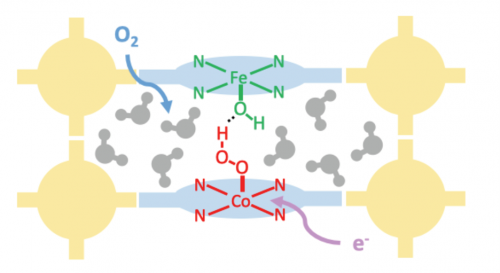
Ambar Kulkarni wins NSF CAREER Award
Chemical engineering assistant professor Ambar Kulkarni is one of 500 recipients nationwide to receive a National Science Foundation (NSF) Faculty Early Career Development Program (CAREER) Award this year. The NSF CAREER Award, the agency’s most prestigious award for early-career faculty, recognizes researchers who have the potential to be role models and leaders in research and education by funding research projects that can serve as the foundation for the rest of their careers.
Kulkarni’s proposal, “Designing 3-Dimensional Active Site Environments in Metal-Organic Frameworks for Oxygen Electrochemistry,” aims to help design better and cheaper catalysts for fuel cell applications.

The project will focus on metal-organic frameworks (MOFs), a type of porous catalyst made of metal cations and organic linkers that acts like a nano-reactor. Current catalysts for the oxygen reduction reaction (ORR)—where O2 is stripped of electrons that are used to power a fuel cell—are currently made with expensive platinum-based alloys, which are difficult to scale for mass-production. This makes finding cheaper alternatives that work as well or better than platinum necessary to the development of this technology.
To help solve this problem, Kulkarni’s team will leverage their expertise in multi-scale molecular modeling, a type of computer modeling that simulates multiple “levels” of physical phenomena at the same time.
“Trying to simultaneously describe the ORR reaction, the dynamics of the water molecules, the diffusion of oxygen and electron-hopping is really challenging,” he said. “This is one of the reasons why a multiscale approach that leverages three different levels of theory is necessary.”
Once the team has developed multi-scale models of the MOF, they can test new combinations of materials to design an inexpensive and effective MOF catalyst for fuel cells. The goal is to use theory to narrow down the nearly endless possible designs as much as they can to help their experimental colleagues accelerate the design, discovery and realization of useful materials.
“This feedback loop between experiment and theory is one of the core principles of our research,” he said. “From the millions [of materials] that we study, we tell our experimental friends which ones they should focus on, and then they can figure out which of those are feasible for experimental syntheses.”
As he begins work on this new project, Kulkarni is thankful for the people who have helped him along the way. He especially credits his CAREER Award success to current Ph.D. student Ty Sours, who recently published a paper on this topic, as well as his advisors and mentors in the chemical engineering department and his collaborators at Stanford University.
He is also excited because the project is a culmination of his career to this point, as it combines his Ph.D. research in classical simulations at Georgia Institute of Technology, his postdoctoral work in density functional theory at Stanford University and his catalysis-focused research at UC Davis.
“It’s beautiful to see the things I’ve learned so far work together so well,” he said. “It creates an opportunity to start looking at phenomena that have been, historically, really hard to study.”
